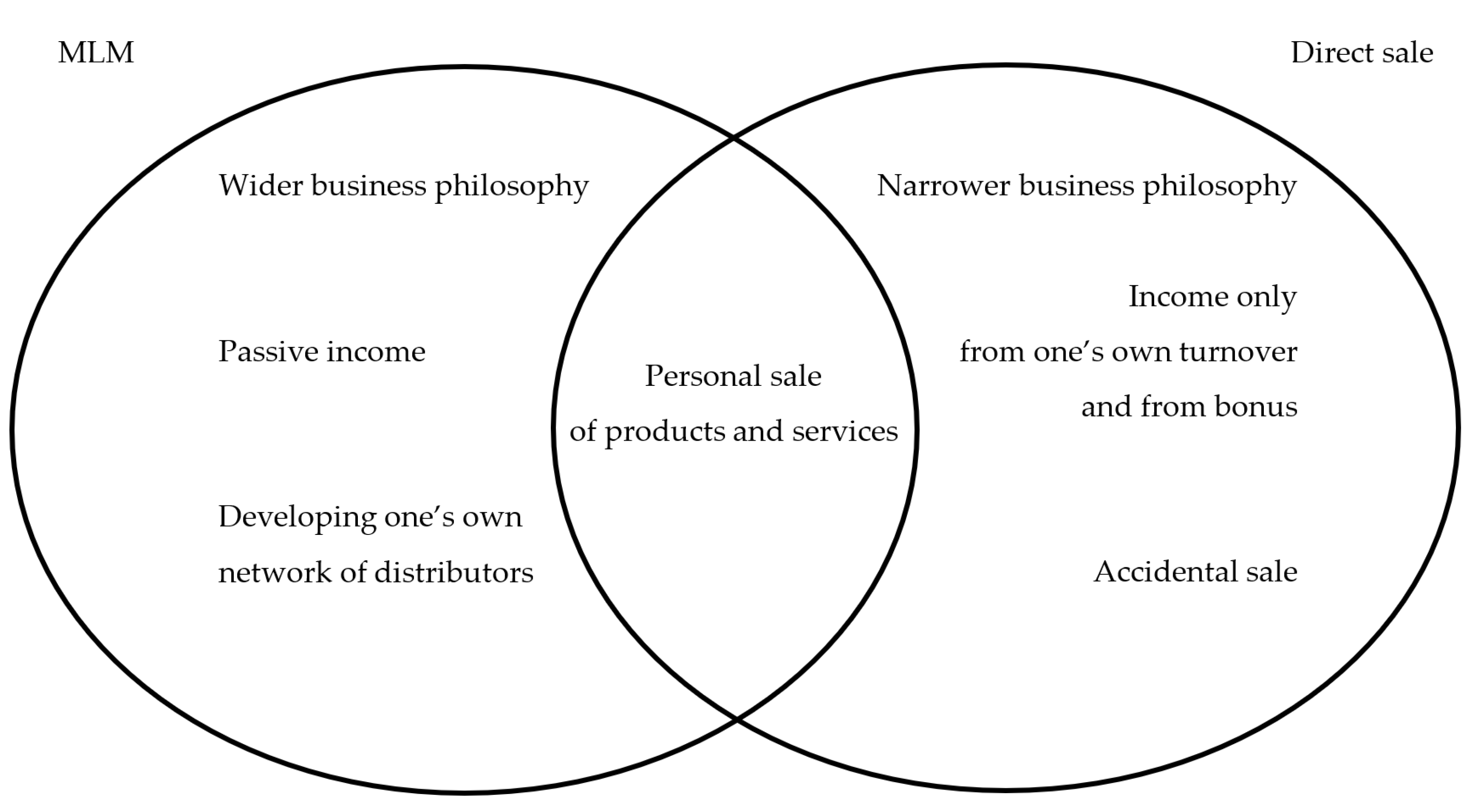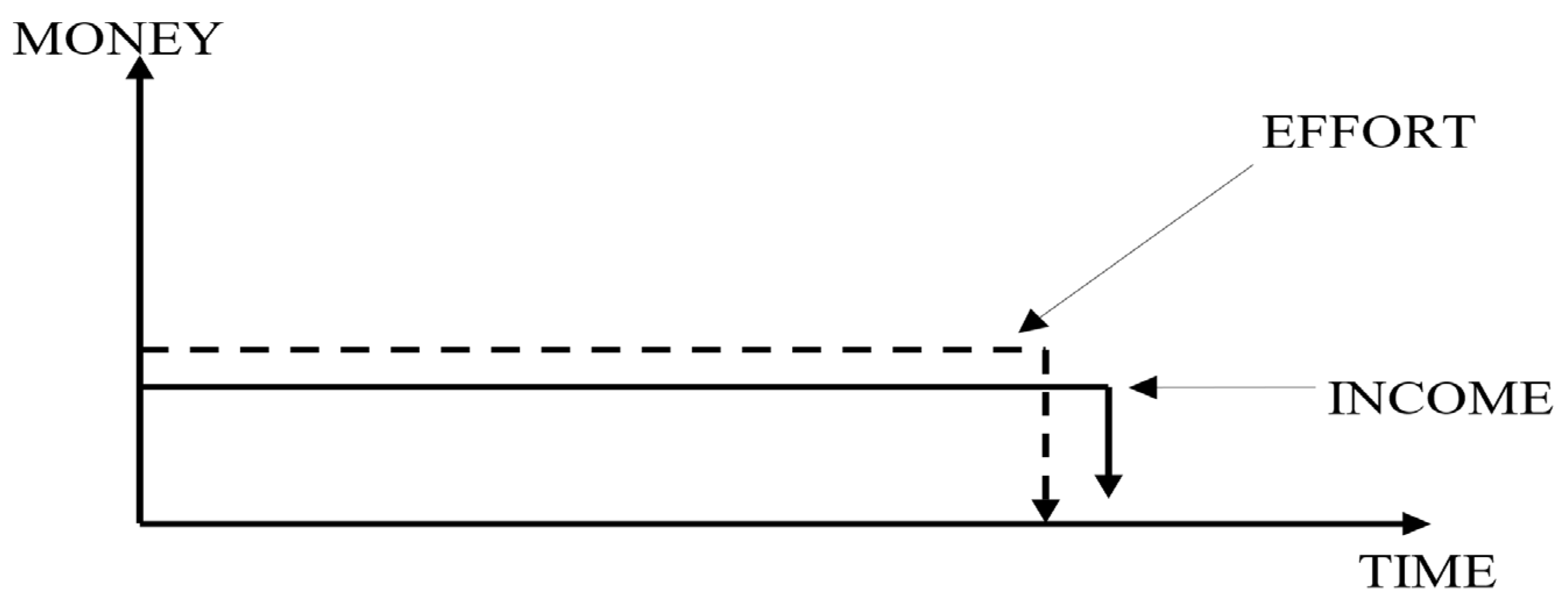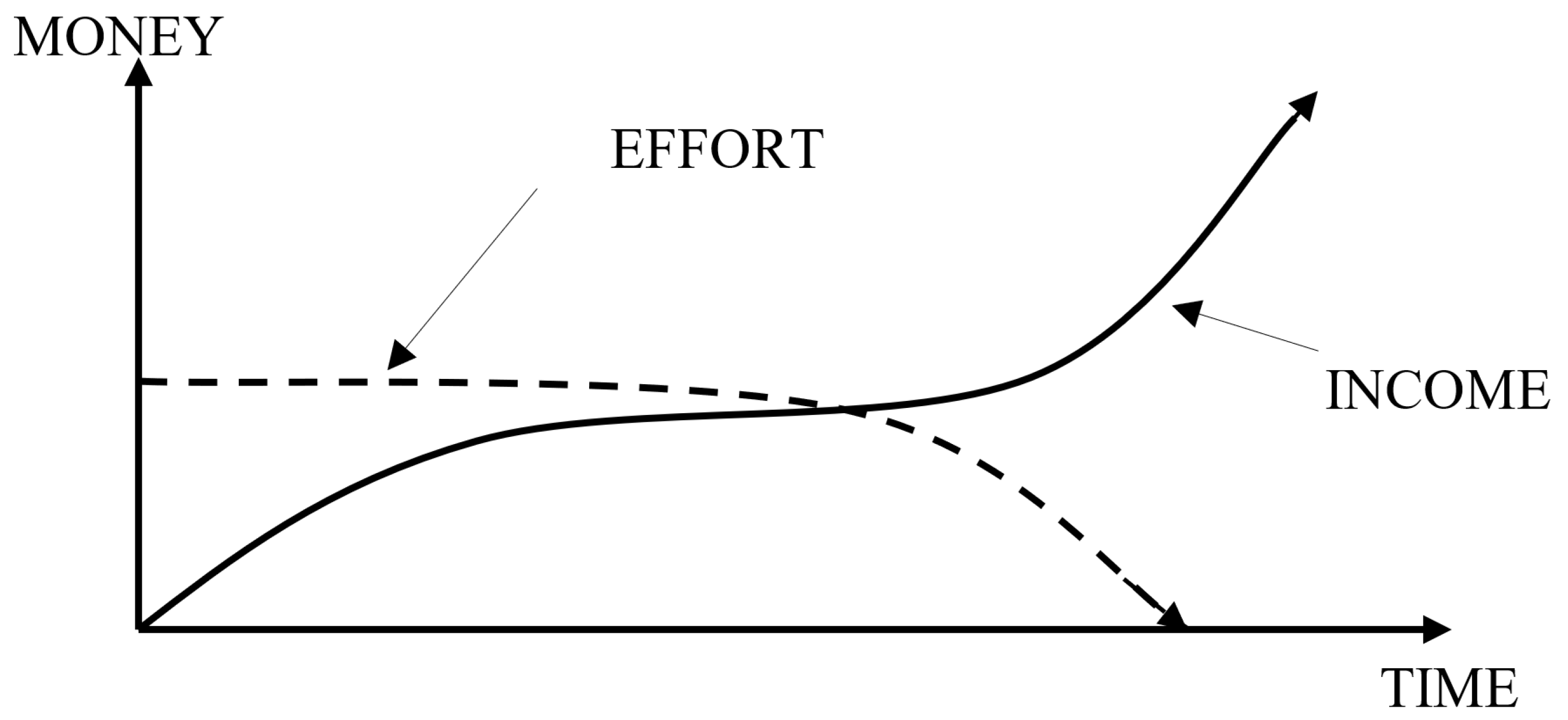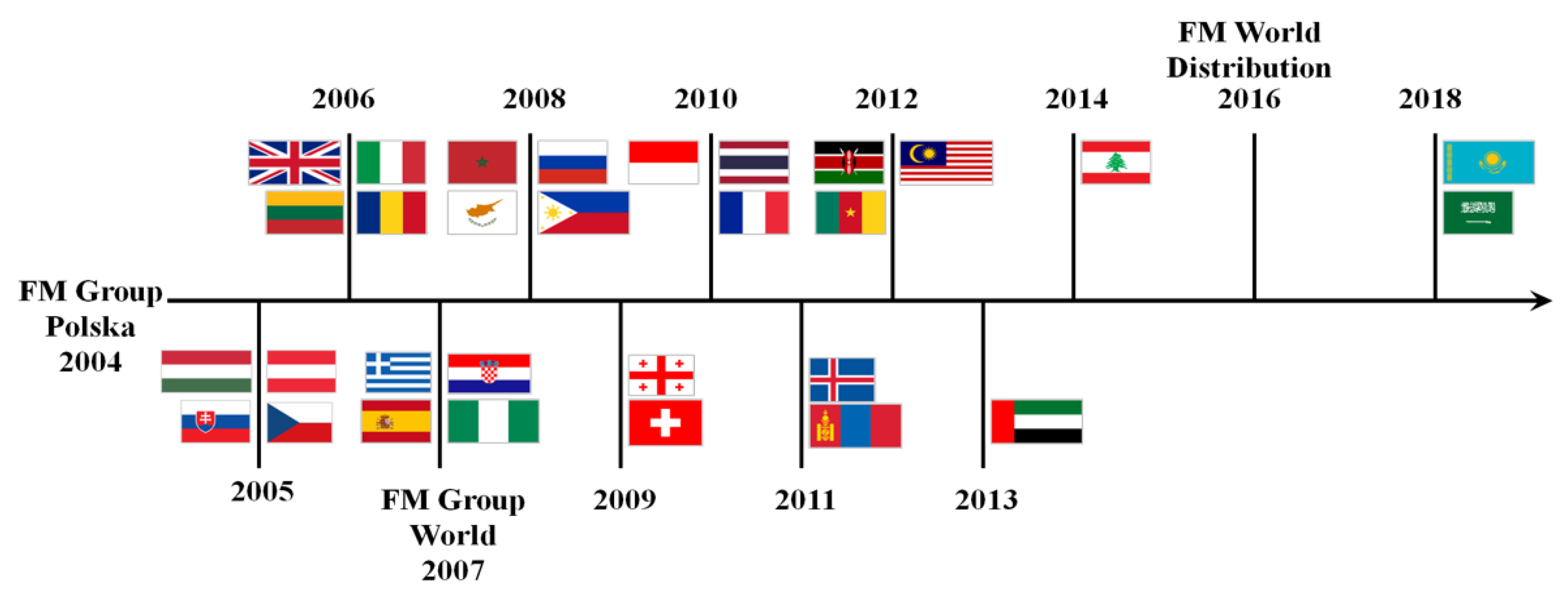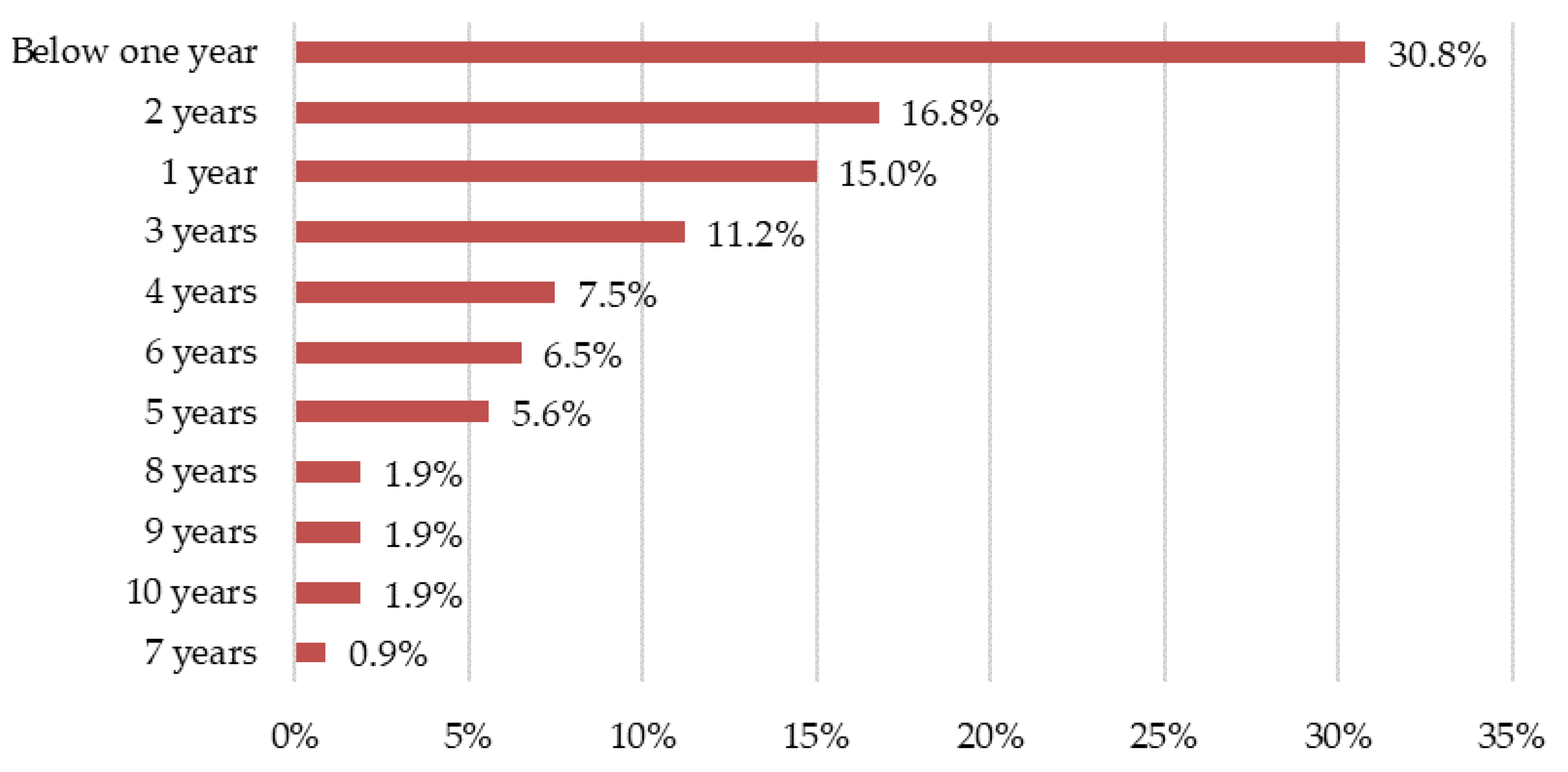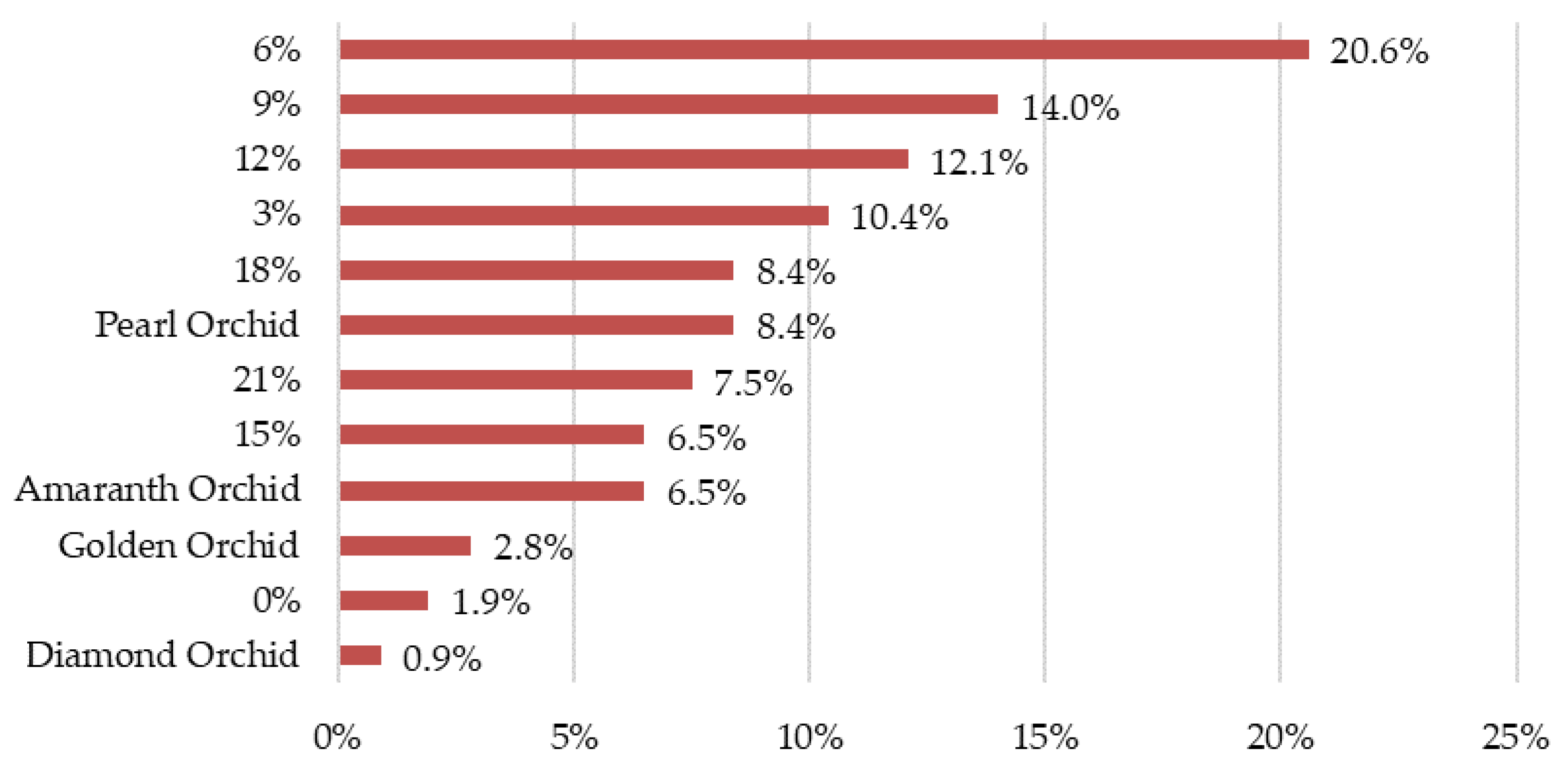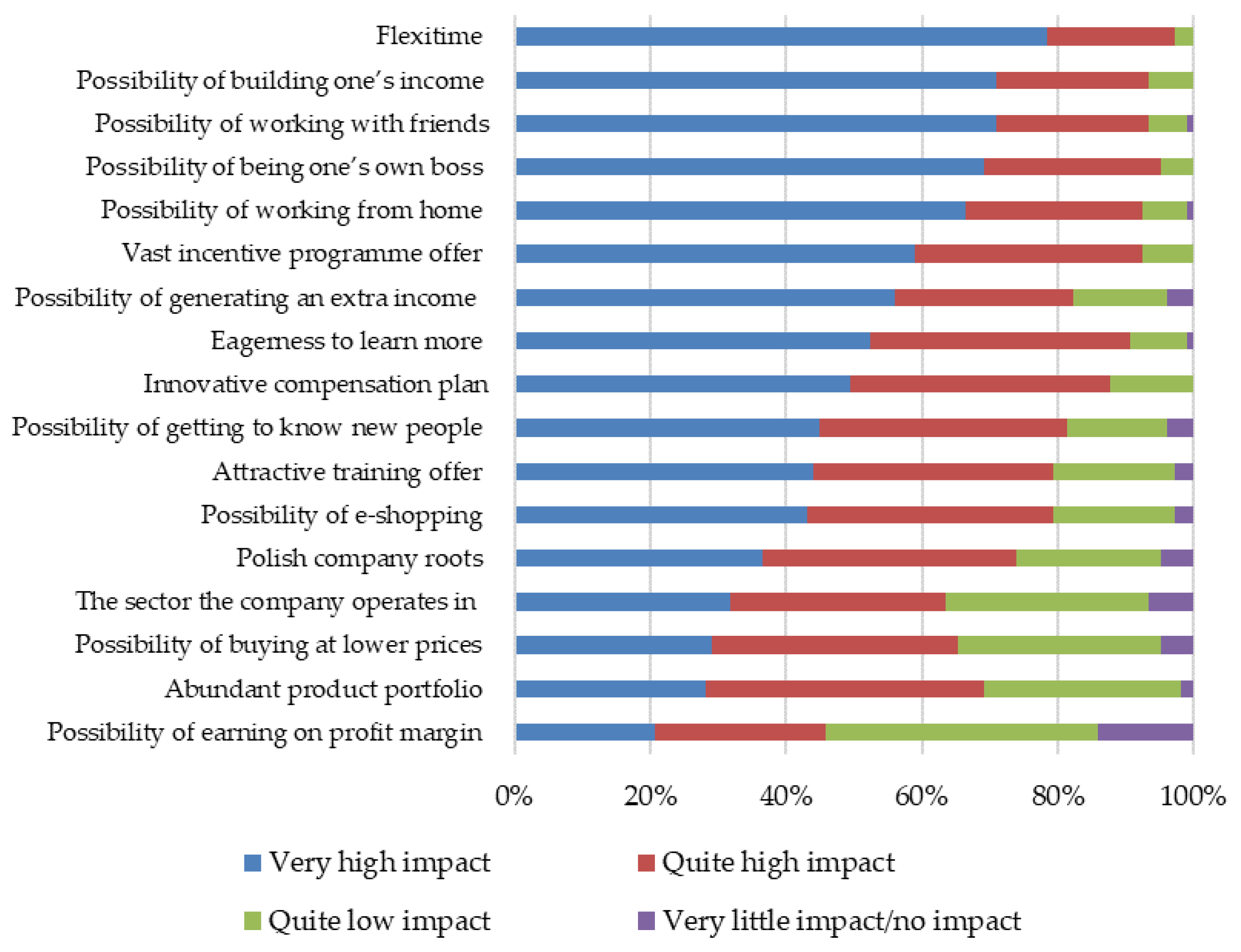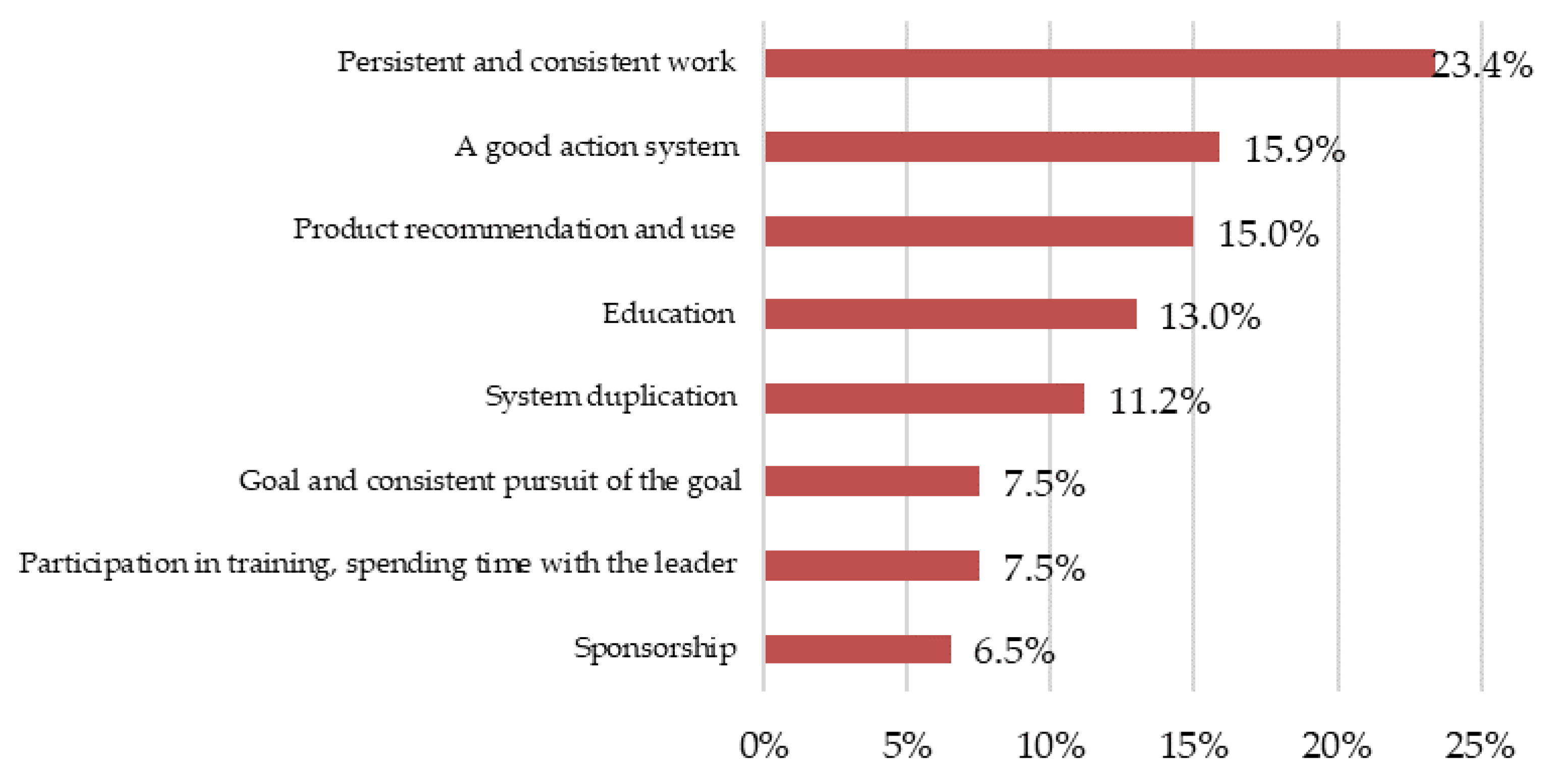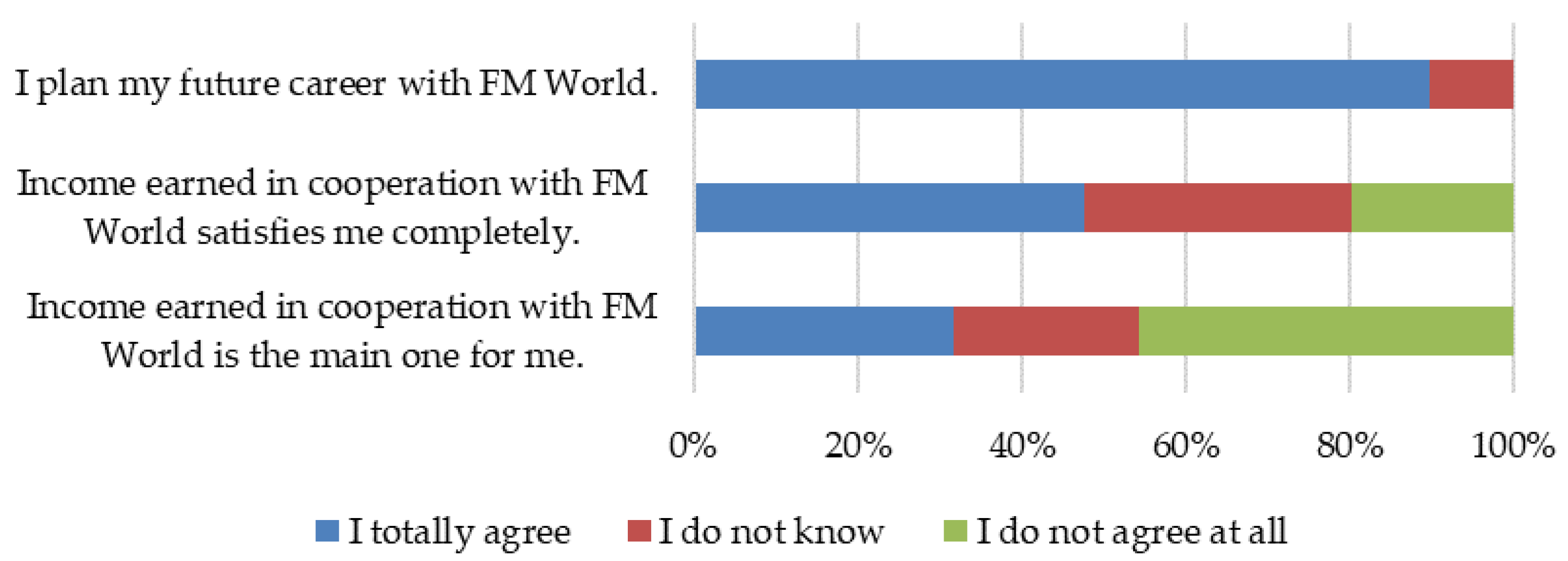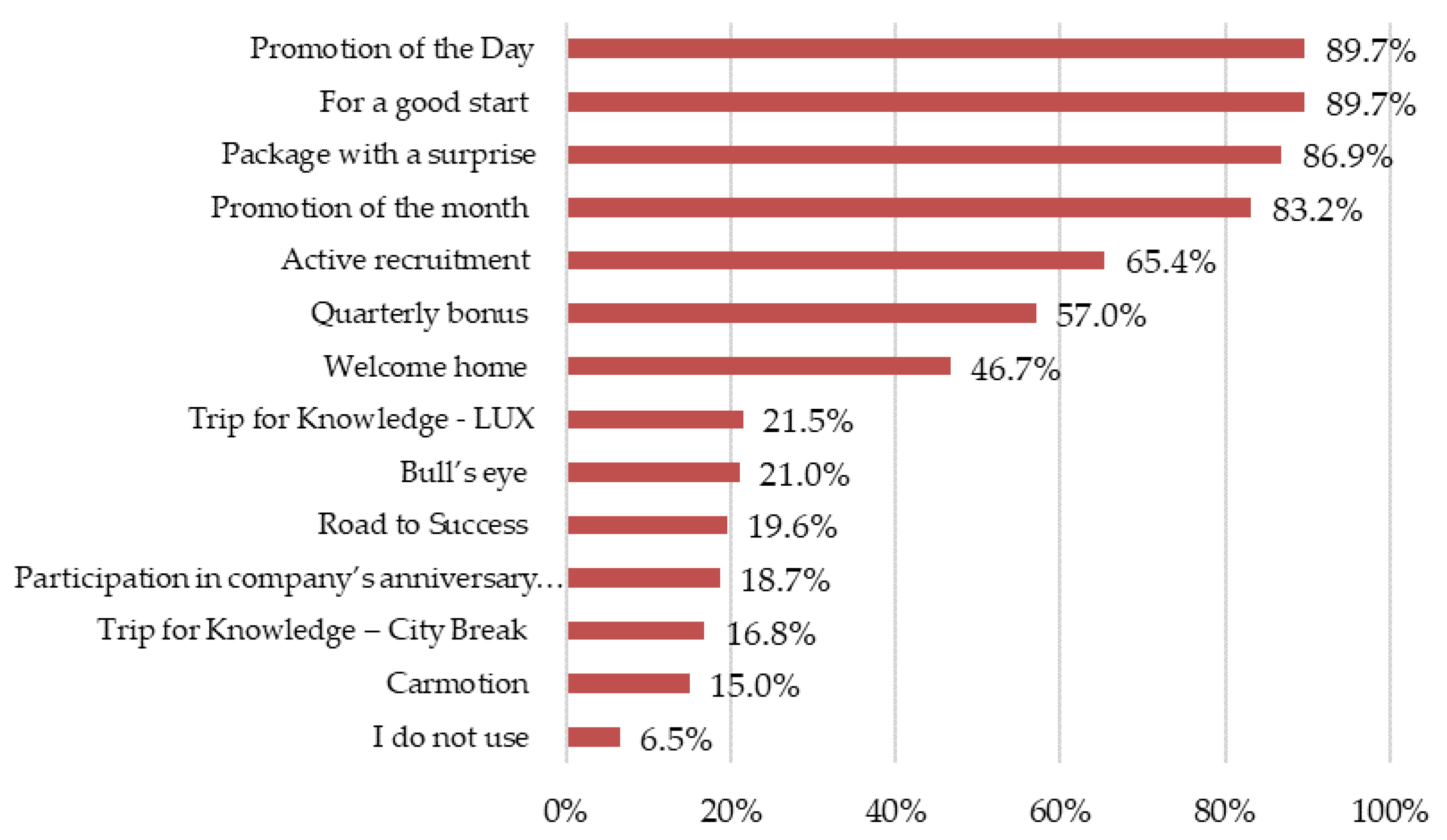1. Introduction
The article offers a closer look at Multi-Level Marketing. In Poland, it is still little known, even though its origins can be traced back to the United States, to the early 20th century. Currently, it is thriving all across the world, winning new markets and expanding at a growing scale [
1].
The applicable literature does not seem to provide an unambiguous definition of network marketing, otherwise known as MLM (Multi-Level Marketing). As defined by the Federal Trade Commission (FTC), Multi-Level Marketing (MLM), otherwise known as network marketing, is “any marketing program in which participants pay money to the program promoter in return for which the participants obtain the right to (1) recruit additional participants, or to have additional participants placed by the promoter or any other person into the program participant’s down line, tree, cooperative, income center, or other similar program grouping; (2) sell goods or services; and (3) receive payment or other compensation; provided that: (a) the payments received by each program participant are derived primarily from retail sales of goods or services, and not from recruiting additional participants nor having additional participants placed into the program participant’s down line, tree, cooperative, income center, or other similar program grouping, and (b) the marketing program has instituted and enforces rules to ensure that it is not a plan in which participants earn profits primarily by the recruiting of additional participants rather than retail sales” [
2].
FM World operates under network marketing, which means that a person who will join the group of distributors is given the possibility of building the so-called consumer network by welcoming other members to cooperate. The compensation of the so-called business partner depends on the effectiveness of the partner’s work, namely the turnover generated by the partner’s user group. Next to building the network, the distributor can provide direct selling of products and services found in the company portfolio. In that way, one can earn on the profit margin which, on average, accounts for 30% of the product price.
The authors of the article decided to have a closer look at network marketing as in Poland it is not quite popular. There is also a lack of detailed data on people working in this structure. The business model diverges from the traditional regular job considerably as it is based on the commission compensation plan and, over a few years, it allows for financial freedom, namely the so-called passive income generating constant revenues [
1].
There are many network marketing controversies. State institutions responsible for market control all over the world undertake to verify thoroughly whether the operation of the enterprises operating in the MLM system complies with the law. It comes from the fact of striking similarity to the systems considered pyramid schemes. The similarity is, however, superficial only, and the ignorance of society can come from two reasons. First of all, reliable scientific elaborations are hardly available on the market. The major resources of knowledge on Multi-Level Marketing are manuals and textbooks developed by its practitioners, motivation speakers or coaches without true economic knowledge as well as blogs and forums, where the evaluation of the author’s reliability is very difficult to verify. Second of all, if one undertakes to provide the characteristics of that phenomenon, they often do it superficially and very generally [
1].
Despite many controversies and limited access to the literature on network marketing, it is a compensation-generating form that is worthwhile. In this paper, there are aspects closely connected to the idea of Multi-Level Marketing to help one understand it. On the example of a company operating in the MLM system, a compensation plan and the possibilities resulting from cooperation in such a system are presented.
3. FM World Enterprise(s) Characteristics
3.1. Origins of the Enterprise
FM World was established in September 2004 by Trawiński [
61]. The company has Polish roots with headquarters in Wrocław. Initially, it was known under the name FM Group Polska; however, over a few years, the company developed considerably and, in 2007, it was transformed into FM Group World. In 2016, it transformed into FM World Distribution, since then distributing the products to every part of the world in six continents [
62]. The way the company developed over years is demonstrated in
Figure 5.
The company was launched in Poland, and then it expanded to the neighbouring countries of Europe. The first foreign branch was established in 2005 in the Czech Republic. At present, it operates branches in 46 countries and delivers its products to 93 countries globally, which makes it a global company.
From the start of the operation, FM World was cooperating with, established in 1995, PERFAND, the owner of which is the father of the founder of FM World, Trawiński. The company produces high-quality women’s and men’s perfumes that the company, FM World, started its career from [
57]. The next partner of FM World is a German enterprise, DROM Fragrances International, headquartered in Munich. The company enjoys many-year experience as it was established in 1911 by Bruno Storp. DROM Fragrances International is one of the biggest producers of fragrance extracts; it cooperates with many cosmetic brands known across the world, especially Hugo Boss and Chanel [
64].
3.2. Enterprise Product Offer
FM World distributors are offered a number of universal good-quality everyday products and services. They are addressed to a large group of consumers across the world, irrespective of their age, gender, education or place of residence [
65,
66,
67]. The company offers products in eight branches: perfumes, white cosmetics, colour cosmetics, coffee and tea, diet supplements, household chemicals, telecommunications services [
68] and the Internet and accounting services [
69].
The company’s first product was perfumes. Currently, FM World’s offer covers 100 various women’s fragrances divided into five fragrance groups: flower, citrus, oriental, wood and chypre. The fragrances of the perfumes for male consumers are half as many; they come in six fragrance groups: flower, chypre, oriental, wood, fougere and citrus. The company also offers nine unisex fragrances. The perfumes have been divided into seven categories which differ from one another in fragrance percentage, price range and packaging. The following collections have been created: Pure, Pure Royal, Pheromone, Intense, Classic Collection, Luxury Collection and Utique [
70]. Some fragrances also provide their equivalents as fragranced balms, shower gels, hair perfumes and antiperspirants, as well as the fragrances-for-home line Pure Home [
70].
3.3. Compensation Scheme
FM World operates under network marketing, which provides the person starting cooperation with complete freedom in selecting business partners and working hours, which is not guaranteed when having a regular job.
When getting registered in FM World, a business partner can choose between two options [
62]:
Customer/consumer: a person buying products only for their own needs and the needs of the closest family, at partner-like prices and with access to promotion, however, without the possibility of building a sales network;
User: a person buying products at a partner-like price, with access to promotion and with a possibility of creating own consumer network.
The user status allows the business partner to earn money in two ways. First of all, the user can buy products at wholesale prices, thus saving on recurring expenses. They can also get engaged in distribution, namely the sale of articles and services to family and friends. By placing an order, the distributor purchases a product at a partner price and thus receives the right to sell it further at the catalogue price, earning from the price difference, the so-called profit margin, which accounts for about 30% of the market price.
Table 5 presents a sample direct profit generated from the sales of products with a profit margin.
The other possibility of earning money in FM World is creating one’s own business by building a network of users, namely bringing new persons who want to start active cooperation with the company and make money on the company’s global turnover. The amount of the money earned by a business partner depends on their engagement in developing a network of consumers. The company awards commission neither in a form of commercial discount nor in a form of compensation for joining the FM World Club only, nor for registering new persons only. Network marketing is a business based on sales and the amount of commission depends, e.g., on the point turnover generated with the entire sales network [
73].
By purchasing a product offered by FM World, the buyer is awarded points for it. The points are accumulated throughout the month, and they provide the grounds for being qualified at a given level of effectiveness from 0% to 21%. The commission received is the sum of the turnover received by the distributor and the distributor’s group over one calendar month; points are earned from the beginning in the successive month.
Table 6 presents the principles of getting qualified for the successive level of effectiveness in the First Marketing Plan.
An important technical aspect is how to build a network of distributors. In Multi-Level Marketing, the idea is not about entering the highest number of people as the company does not pay a commission on the number of people invited to cooperation but on the total turnover of the structure and on the percentage difference between the so-called sponsor and the persons in their network. For the network to operate adequately, it is enough to register three to five people who will also get engaged and who will create their own networks of distributors.
Sample calculations of the leader’s commission are as follows:
A given structure is built on six levels A, B, C, D, E and F, where level A receives 12,000 group points, thus reaching a 15% effectiveness level. Level B is awarded 7900 group points and reaches 12%. Level C accumulates 7200 group points, which also makes it reach a 12% level. Levels D, E and F accomplish a 9% level by accumulating 5300, 5100 and 5000 group points, respectively. The leader, thanks to the accumulated group points and personal purchase points (100 points), accomplishes 42,600 group points and thus reaches a 21% effectiveness. To calculate the leader’s commission, the effectiveness of respective levels below the leader must be deducted from the leader’s level. The differences must be multiplied by the group points accumulated by distributors of a given structure.
Personal purchase: 100 points × 21% = PLN 21
A: 12,000 × (21–15%) = PLN 720
B: 7900 × (21–12%) = PLN 711
C: 7200 × (21–12%) = PLN 648
D: 5300 × (21–9%) = PLN 636
E: 5100 × (21–9%) = PLN 612
F: 5000 × (21–9%) = PLN 600
In total, the compensation amounts to PLN 3948.
The next stage of a career path in FM World is the Second Marketing Plan. It creates a possibility to get even higher compensation.
3.4. Incentive Schemes
FM World offers a number of promotions and incentive schemes. Their purpose is to provide knowledge and tools as well as to motivate the business partner to make an effort to care for their structure to ensure higher profits both for them and for the company [
74].
Promotions addressed to all the business partners registered in the company include a “happy hour”, a promo of the day, a weekend promotion, a promotion of the week and a monthly promotion. The first four promotions most often involve a price discount or an increase in points of specific products, while the promotion of the month allows each business partner to place an order with the adequate point value for purchasing an additional product package at the price of PLN 1.23. There are two different product sets to choose from, with eleven variants in each, depending on the order value [
75].
“Package with a surprise” is a welcome promotion for newly registered distributors. Each new business partner who, within 14 days after the registration date, places an order corresponding to the value of minimum 100 personal points, receives a surprise gift of the catalogue value of about PLN 30 and a free order delivery [
76].
“For a good start” is an incentive scheme to facilitate new business partners getting to know a wider range of products. The promotion is divided into three stages, each for one month, as demonstrated in
Table 7. The first stage starts with a distributor registration in the company [
77].
“Active Recruitment” scheme is addressed to the leaders who recruit new active business partners. If in the first month from registration a new person places the first order with a minimal point value, as given in
Table 8, the recruiting person will receive an additional compensation/commercial discount dependent on the point turnover of the new distributor [
77].
“Quarterly Bonus” is an incentive scheme addressed to distributors from 0% to 18%. If a business partner in each of the three successive months does shopping for minimum 250 points, they receive an additional quarterly discount accounting for 25% of the total commercial discount awarded for three successive months in which the conditions were met [
77].
“Welcome home” is a scheme to motivate distributors to build a model structure where 21% is made of six levels. For each month in which the model structure is built and the additional conditions, including personal and group points as well as point turnover of the base month, are satisfied, the company pays the distributors the amount of PLN 2000 to the distributors for their own expenses. The scheme can be used twice at each level of effectiveness from 9% to Amaranth Orchid [
68].
One of the most attractive incentive schemes is “Trip for Knowledge”, addressed to the distributors at the level of effectiveness from 0% to 18%; it guarantees to its laureates training in the most beautiful parts of the world. The business partner gets qualified for such event if, in the base month, they fell in the range from 0% to 18%. If they reach the target level and maintain it for the successive two accounting months, they receive one or two trips depending on the level they were promoted to. The principles of being qualified for the training are provided in
Table 9. City Break is a 3–4-day trip. Participants of previous editions visited, e.g., London, Barcelona and Prague. LUX is a 5–7-day training. The laureates have so far visited Majorca, Kenya, Jordan and Tenerife and enjoyed a cruise in the Mediterranean Sea [
78,
79,
80].
FM World wants to reward its best leaders, and thus it gives them an opportunity to participate in the company’s anniversary celebrations held in the most luxurious global destinations, e.g., the Maldives or Singapore. The company covers all the business partner’s flight and stay costs. To be invited, the leaders who, in the base month, found themselves at any level of the First Marketing Plan or at the Pearl Orchid Level, over the qualification time [
77]:
Must at least five times repeat the level of Pearl Orchid or higher;
Once they reach the Pearl Orchid level for the first time, cannot fall down more than one level, not lower than to the Golden Magnolia level;
Must have an active agreement of participation in the “Road to Success” incentive programme, a luxurious car programme.
“Bull’s eye” programme is addressed to Pearl and Amaranth Orchid leaders. If a distributor manages to maintain the point turnover of their structure of the base month and receive at least 100 personal points for each branch that has accomplished the level of effectiveness of minimum 12%, he or she will receive an additional compensation every month, see
Table 10.
The last incentive programmes offered by the company are “Carmotion” and “Road to success”, a luxurious car programme. As part of the first programme, a distributor can receive an additional compensation which will help the payment of the leasing instalment or the payment of long-term car rental, and if they already have their own car, the commission will help cover the depreciation costs. “Road to Success” is a programme offering, to the business partners above Golden Magnolia, an additional compensation for the payment of leasing instalment of the car of one of the three luxurious makes: Mercedes-Benz, Mazda and Porsche. The distributor who repeats the level of effectiveness three times in successive months gets qualified. Additionally, thanks to the agreement signed with the dealers of those car makes, the distributor can collect the car in any dream colour, with dream accessories and with a substantial discount, as compared with the car market price. For example, for Mercedes-Benz, it can be even 23% of the price.
Table 11 presents the principles of qualification at respective levels and a sample amount of additional compensation [
68].
An incentive system is a system of interconnected and supporting-one-another incentive means which, creating a coherent whole, are to serve the execution of the mission, vision, strategy and accomplishing the goals of the company [
44]. Dedicated by FM World, to business partners, it is understandable and oriented at the needs of individuals.
3.5. SWOT Analysis
For the adequate development and operation of the company, the analysis of its market position is very important [
80]. For that purpose, the SWOT strategic analysis for a comprehensive evaluation of the company’s business environment and its internal analysis is most frequently applied. The term SWOT is an acronym of “Strengths”, “Weaknesses”, “Opportunities” and “Threats” [
81].
Table 12 presents the SWOT analysis performed for FM World.
FM World is very strongly rooted in global network marketing. Thanks to the good quality, the products and services enjoy a good reputation and win many awards, not only for the product offer but also for the compensation plan and the organization management method. The company keeps developing; every year, it launches new products, thus using more and more innovative technologies so far not used by competitors. The company uses its opportunities, e.g., cooperation with dietitians or beauty professionals. The company is open to Internet communication development, which can be seen from its presence on social media.
4. Aim, Hypotheses, Material and Methods
The key objective of the paper is to present a compensation plan and the possibilities resulting from cooperation with FM World operating based on network marketing.
The paper provides two hypotheses:
There is a positive relationship between the number of FM World distributors planning further cooperation with it in the future and the period of its cooperation so far.
Most of the surveyed distributors of FM World assess the effectiveness of incentive programmes at a very good level.
For the purpose of this paper, a study was performed with FM World distributors. The basic criterion affecting the sample selection was belonging to Rentierzy.FM group including some business partners in Poland and globally.
The research method involved a diagnostic survey. The respondents were selected with a snowball method involving a nonrandomized selection of the sample by participants being recruited by other participants [
75].
The study was performed in June 2019. The research tool used to collect the answers was an online survey questionnaire; the respondents answered fifteen questions.
The study group included FM World distributors (the characteristics of FM World are presented in
Section 3). The sample was selected on purpose, and it is not a representative sample as it does not cover the opinions of all the registered business partners.
Table 13 provides the study group characteristics.
The sample included 107 persons: 44 women and 63 men, 16 to 65 years of age. The most numerous group included persons aged 21 to 26 and 27 to 35. About 30% of the respondents cooperated with the company for less than one year; there were also respondents cooperating for more than 7 years. The earnings of more than half of the respondents were below PLN 5000, while the respondents with income ranging from PLN 5000 to 10,000 accounted for 29% of all the respondents.
6. Conclusions and Discussion
Interestingly, over the recent years, the network marketing sector has been booming and recording an increasing interest. On the other hand, many people believe in fake news about that business model, e.g., considering it a pyramid scheme. The practitioners of Multi-Level Marketing face a serious challenge: influencing social awareness and rectifying controversies patiently.
The present times are a period of accelerated growth. New opportunities emerge almost overnight. Facing a lack of job market stability and unsatisfying earnings, people of every age are searching for alternatives that would provide them with a higher standard of living. Network marketing comes to face those challenges as a business everyone can learn and, in the long run, accomplish a passive income from.
The paper provides the characteristics of the compensation plan, especially its functions, goals and traditional forms of payment. It covers the essence of the key motivation theories for organization management and provides the most essential ones with characteristics. Network marketing was discussed, and its controversies and opportunities were considered. The marketing strategy and the principles of compensation operating in FM World are given.
The main goal was achieved through the characteristics of the remuneration system and opportunities resulting from establishing cooperation with FM World. With the data collected in the survey, one can note that FM World offers interesting income possibilities. The amount of compensation of the respondents is, to much extent, influenced by their job seniority, however, mostly by consistent, persistent and regular actions. The respondents, when referring to income, considered not only the performance-related commission but also cashless forms of income; incentive programmes the respondents benefit from with eagerness.
Most of the respondents were young people, however, despite it, frequently with high performance in the company. It suggests a conclusion that the results do not depend on the life experience of the person but on the engagement. Many respondents were serious about business and slowly but steadily were going up the performance ladder. There were also a few respondents with greater experience, found in the Second Marketing Plan, who, with their action, had generated a passive income for themselves as their only source of income. High performance provided them with an opportunity to benefit from some incentive programmes, especially “Road to Success”, “Carmotion” and “Trip for Knowledge”, or from taking part in the company’s anniversary celebrations. Thanks to it, the respondents could drive premium-class cars and visit the most beautiful parts of the world.
The hypotheses assuming, firstly, that there is a positive relationship between the number of FM World distributors planning in the future further cooperation with it and the period of its cooperation and, secondly, that most of the surveyed distributors of FM World assess the effectiveness of incentive programmes at a very good level were positively verified. The aim of the article was achieved, and two research hypotheses were verified in the course of extensive theoretical studies and primarily on the basis of empirical research. Incentive programmes were a factor that encouraged the respondents to do more intensive work, as they were aware that they would be rewarded for performance.
Moving on to the discussion, it should be noted that many authors addressed similar issues. Their work focused, for example, on the use of databases to develop methods and tools showing the essence of network marketing. The authors used several variables in their works to show the problem of the functioning of network marketing and its importance in the world. Many authors have used the Systematic Literature Review (SLR) to present the essence of network marketing [
82,
83,
84,
85].
A similar understanding of network marketing was presented by Choudhary and Kamal [
82]. In their opinion, Multi-Level Marketing covers more and more areas today. In their study, they focused on the insurance industry. Selling insurance policies has traditionally been considered demotivating and tiring work until the MLM’s power to increase policy sales was discovered. Due to the growing competition in the insurance sector, companies are looking for innovative methods of disseminating news and obtaining the maximum number of transactions in a shorter time. Many fairly large local MLM companies in the market team up with leading insurance brands to promote their products along with an assortment of their products. They examined in their work the economic and social impact of MLM as a tool that can influence society by generating employment, mobilizing long-term funds and improving people’s quality of life.
Sreekumar [
83] also presented MLM in the insurance business in his work. The insurance sector offers the possibility of long-term indebtedness to the economic development of the country. At the same time, the MLM path provides employment opportunities for thousands of people and strengthens their social status.
Li, Nontasak and Tubsree [
84] examined the core competences of successful Chinese Multi-Level Marketing business distributors in their work. In addition, they identified the challenges facing Chinese business distributors in MLM. The research was conducted among distributors who worked for Corporation X, which is one of the typical MLM business companies in China. In the study, they used a qualitative approach with in-depth interviews and targeted selection. The data were collected from 14 MLM business distributors, all of which achieved medium or higher positions in Corporation X. Their research showed that the following are important in MLM: self-motivation, leadership, entrepreneurship, business attitude, knowledge of running a business, business expertise, long-term people orientation and business ethics.
Padhi and Nath [
85] believed that the company’s Multi-Level Marketing system is a new generation business style in which personal credentials are the basis of business networking. Morality, ethics, commitment and motivation are key tools for personal and business development. Business development manifests itself ethically, regardless of many frauds and distortions of business plans. Their case study explored the social responsibility of MLM companies in Odisha (India).
To recapitulate, network marketing is a good alternative for persons looking for a job to do. Multi-Level Marketing innovativeness makes it possible to work in any place on earth, at any time one likes, with the people one cares about [
76]. Consistent and regular work and involvement to accomplish one’s own goals as well as frequent participation in training and emphasis on personal development are the key to becoming successful in the network marketing sector. That business is mostly based on a relationship with another person, and thus, last but not least, to quote the response of one of the respondents, “According to the authors, it is the people who are most important in network marketing. How they approach it depends on their success in that company”.
The topic presented in the study is important, and therefore the implementation of the original research was the main goal. A new methodological element in this article was organizing the concepts of remuneration systems, the theory of motivation and the essence of network marketing. The discussed topic is very extensive, and the study was not exhausted. Network marketing during the SARS CoV-2 pandemic records dynamic changes, and thus tracking the problem and conducting similar research is important; for example, it would be justified to demonstrate the impact of the COVID-19 pandemic on the profitability of selected MLM companies. Further research is also necessary because research in this area has rarely focused on the influence of SARS CoV-2 on the development of network marketing.
